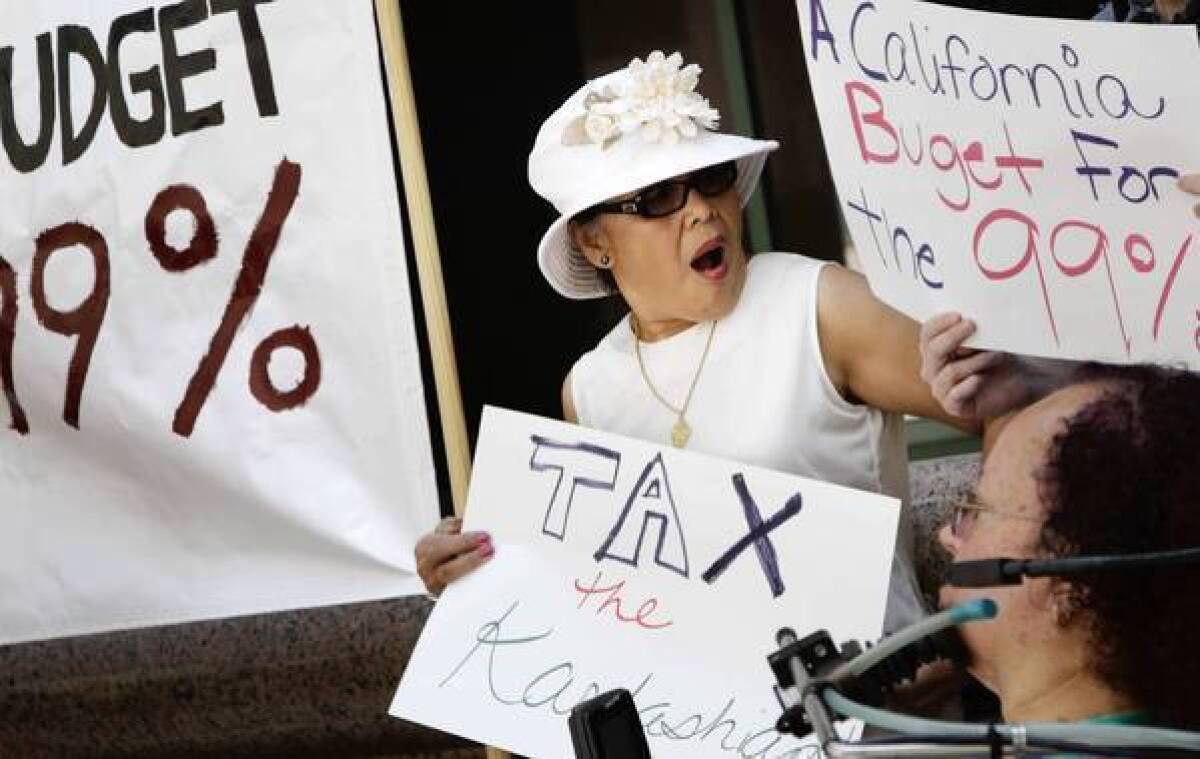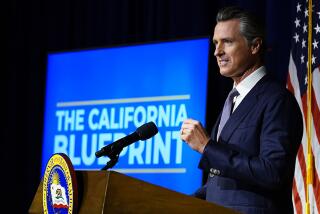Jerry Brown’s plea to voters: ‘Please increase taxes temporarily’

SACRAMENTO — Gov. Jerry Brown released a plan to close California’s rapidly growing deficit by switching state offices to a four-day week, slashing welfare benefits and healthcare for the poor and relying on a variety of short-term fixes — all in the hopes that voters will give the state some breathing room by raising taxes in November.
The governor, who unveiled his revised budget proposal in the Capitol on Monday, is facing a nearly $16-billion budget gap, far larger than the $9.2 billion he predicted in January. He warned that the deficit could grow significantly if voters reject his proposed ballot measure to raise the state sales tax and income levies on the wealthy.
That would trigger additional cuts, including reductions in public education equivalent to lopping three weeks off the school year, he said.
“I’m linking these serious budget reductions … with a plea to the voters: Please increase taxes temporarily,” Brown said at a morning news conference.
His $91.4-billion spending plan sets up confrontations with interests that are supporting his tax campaign. To save $400 million, he’s negotiating with public labor unions to reduce the state workweek to 38 hours, worked over four days — a 5% cut in payroll costs. And he’s pushing fellow Democrats in the Legislature to accept steep cuts in social services, which they have so far resisted. Brown acknowledged that budget negotiations will be especially challenging.
Brown’s announcement is the starting gun on a month of intense debate on the spending plan, which the Legislature must pass by June 15 so it can go into effect at the start of the new fiscal year July 1.
The proposed cuts would cover a shortfall caused by lower than projected tax receipts, an increase in school spending under a voter-approved funding formula and the refusal by the federal government and the courts to allow cuts the state had already counted.
In addition to slashing expenditures, the governor is trying to patch the unexpectedly large budget gap with any spare change he can find, including $300 million the state received as part of the national settlement on mortgage wrongdoing and $1.4 billion in funds surrendered by local redevelopment agencies in January. His plan also relies on some borrowing and raiding dedicated funds to help pay the bills.
Brown, who promised voters while campaigning in 2010 that he would end years of budget trickery in Sacramento, acknowledged that he was relying on “one-time revenues to handle one-time problems.”
He added: “This is the best that I could do.”
The revised spending plan would cut Medi-Cal, the state’s healthcare program for the poor, by $1.2 billion. That includes slicing funds for hospitals and nursing homes.
Home care for the elderly and disabled is also on the chopping block, with a proposed $225 million cut that would include 7% shaved from aides’ hours. Brown would also push forward with $1.3 billion in reductions to welfare and child care.
“You name it, and we’ve got to cut it,” he told reporters Monday afternoon in Los Angeles, where he had flown to hold another news conference.
Advocates for the poor and ailing criticized the Brown administration’s choices.
“It’s the same people year after year who are the victims of the budget ax,” said Deborah Doctor, a lobbyist with Disability Rights California.
Senate President Pro Tem Darrell Steinberg (D-Sacramento) said his Democratic caucus would propose smaller cuts to social service programs such as welfare and home care.
“There is a balance between making necessary cuts, which we will do, and maintaining and preserving essential services for people, especially people most in need,” Steinberg said.
He and other Democratic lawmakers resisted making cuts the governor requested earlier this year, causing the state’s deficit to grow by $400 million, according the Brown administration.
Brown widened his earlier proposed cuts to include temporary reductions in court funding, including a delay in 38 construction projects. The proposal would force trial courts to reach into their reserve funds to pay the bills.
California Chief Justice Tani G. Cantil-Sakauye, who called for an emergency meeting of judicial leaders Monday, called the cuts “devastating and disheartening.”
“They will seriously compromise the public’s access to their courts and our ability to provide equal access to justice throughout the state,” she said in a statement.
Even Brown’s gloomy forecast includes some economic growth. It counts on a $1.5-billion boost from Facebook’s Wall St. debut and a sharp uptick in new home construction. And the governor has not backed down from his boldest — and costliest — proposals.
“I am a buoyant optimist,” he said. “We’re going to build high-speed rail.”
The spending plan includes the sale of $3.5 billion in voter-approved bonds to fund the first segment of a train linking Southern California and the Bay Area.
Republicans on Monday sharply criticized Brown for pushing for new taxes.
“We believe this updated proposal is part of the governor’s strategy to try and fool Californians into accepting a costly tax increase as a necessary step,” said a statement from Assembly Republican Leader Connie Conway (R-Tulare) and Assemblyman Jim Nielsen (R-Gerber).
Without the taxes, Brown said, there would be an extra $6.1 billion in cuts. Besides $5.5 billion in reductions in K-12 schools and community colleges, the University of California and California State University systems would be cut by $250 million each. Other popular programs, such as lifeguards at state beaches, would also get the ax.
University officials unsuccessfully pleaded with Brown to increase their funding to help avoid tuition increases or enrollment cuts. Without more funding, UC students could end up paying 6% more, and Cal State students, who already are set to pay a 9% hike next fall, will face more limits on enrollment in the spring. Both systems warn of much more severe measures if voters reject the proposed November tax measure.
Brown said he was open to suggestions on better ways to close California’s budget gap but said that the state had to live within its means. Anticipating strong reactions to his proposal, he asked for “a modicum of stoicism.”
Times staff writers Maura Dolan, Larry Gordon, Anna Gorman, Patrick McGreevy and Nicholas Riccardi contributed to this report.
More to Read
Get the L.A. Times Politics newsletter
Deeply reported insights into legislation, politics and policy from Sacramento, Washington and beyond. In your inbox three times per week.
You may occasionally receive promotional content from the Los Angeles Times.











